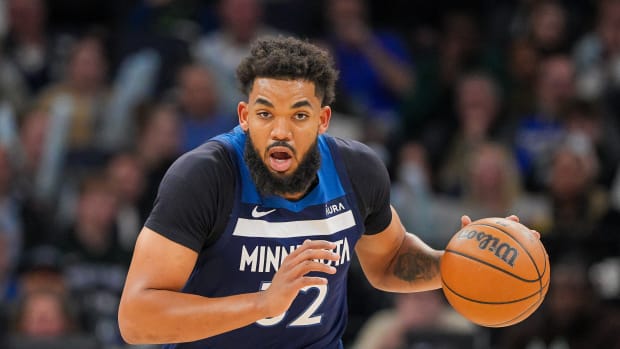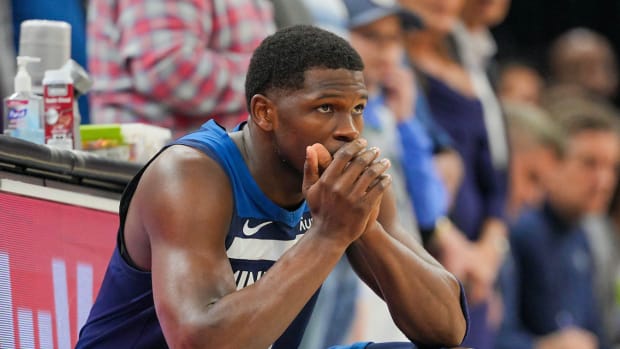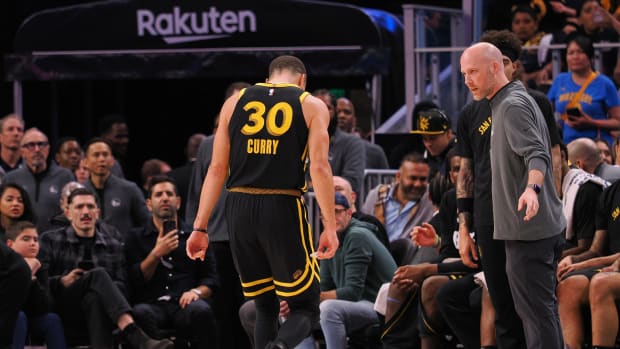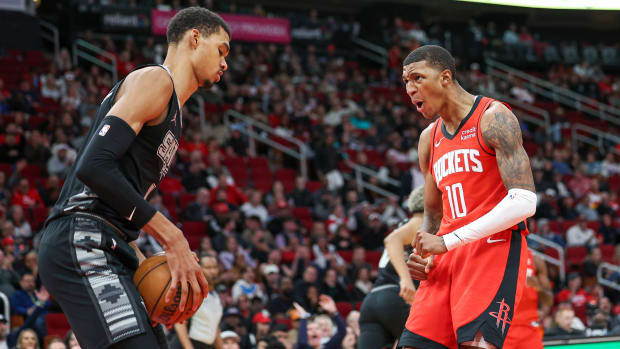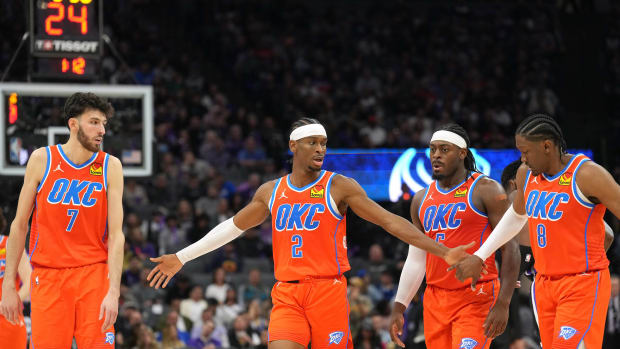J.J. Barea's injury strips Mavericks of major driving force
The Dallas Mavericks are painfully incomplete. For weeks they held their season together with makeshift lineups and careful orchestration in the face of mounting injuries. On Saturday they finally fell apart; Oklahoma City shredded Dallas with a 38-point victory in Game 1 of their first-round series, rendering the grit and guile of the stopgap Mavs inconsequential. It was as if the roster itself had quietly reached its breaking point.
Dallas had survived without Chandler Parsons, who watched from the sidelines as his teammates won seven of eight critical games in the final stretch of the regular season. They made do while Deron Williams nursed a sports hernia—the same ailment that will likely sideline him for Game 2. The injury and absence of reserve guard J.J. Barea, however, appears to be one too many. It’s crazy to think that a functional rotation might hinge on the presence of a 5’10” career backup. Yet Barea has long embodied the power of the specific, proving nightly that the right player working alongside the right teammates and under the right coach can have an outsized impact on a game’s proceedings.
Mavs’ J.J. Barea aggravates groin injury during loss to Thunder
There would be no playoff basketball in Dallas this season if not for Barea. His presence in the final 10 games coincided with the best minutes the Mavericks had in them, a fact noted and rewarded by the league office in early April. Player of the Week honors are typically the purview of superstars. Barea earned his as an exceptional role player. In filling a need, he put together the most impressive and productive stint of his career: averages of 21 points (on 52.6% shooting) and six assists per game over the course of six consecutive wins.
“At the end of the year, I always play better,” Barea said.
That may be true, but never quite like this. Barea gave Dallas the driving force it needed when no other guard on the roster could. It was through his work in the pick-and-roll that a deliberately slowed offense found the means to subsist. Once Rick Carlisle deemed half-court basketball to be the Mavericks’ best chance of winning, Barea’s ability to streak into the paint became all the more important. That downhill quality was noticeably absent as Barea limped through the first half of Game 1 against the Thunder, his quickness sapped by a strained groin.
No other Maverick can provide a reasonable facsimile of Barea’s contributions. Even a healthy Williams plays a fundamentally different style, while Raymond Felton and Devin Harris aren’t quite as explosive in turning the corner. Dallas will lack for that element in any game Barea misses. Even if he returns, the Mavs would pay a price for every fraction of a second that Barea delays on his drives due to nagging injury. The margin for error is that thin—both for an undersized guard in the world’s best basketball league and a Mavs team overwhelmed by the Thunder’s length and athleticism.
Barea would not win this first-round series for Dallas, but the fact that he cannot play creates a distinct void. Gone is Dirk Nowitzki’s most natural pick-and-roll partner, the team’s most committed driver, and the improbable game manager of a low-turnover offense. The very idea that Barea, long a change-of-pace guard, would be able to offer calm in a calculated system once seemed impossible. Lately he’s worked as an extension of Carlisle, his eyes trained to the sideline as his coach arranges every half-court possession.
“I don't think I could've done this back in the day,” Barea said. “Now I'm more experienced. I do a little of both: Slow it down and you get to relax a little bit, or just run and get everybody involved.”
It is not a coincidence that Barea only became a real, live NBA contributor after Carlisle took over as the head coach of the Mavericks in 2008. It was clear immediately that Carlisle saw something in the waterbug guard that his predecessor, Avery Johnson, had not. Barea climbed up the pegs of the rotation to claim more than 20 minutes of playing time per game in that first season under Carlisle and was given specific, pointed directives. “I remember every time I came in, the first play was high pick-and-roll,” Barea said. “We went from there.”
• MORE NBA: Playoffs off to lopsided start | Hornets left in familiar position
Many bench creators are valued for how they can be left to their own devices. Carlisle came to appreciate Barea, on the other hand, for how he complemented Dallas’s best player. It was in 2011 that the Mavs made a data-driven decision to align Nowitzki’s substitution patterns with Barea’s. The future Hall of Famer would exit games after roughly six minutes so that he could check back in later alongside the undrafted backup. Once Barea began operating in the pick-and-roll with Nowitzki on a full-time basis, he found open lanes unlike anything he had ever seen before.
“When you're running a pick-and-roll with Dirk, people think I'm looking for him,” Barea said. “I’m not. I'm trying to be super aggressive on my shot. And then, if I can't shoot it or if they pay attention to me, then he's gonna be open. Dirk [draws] so much attention to him—guys want to hug him and stay with him so that opens up everything else for me.”
That order of operations for Barea is important. Given the particulars of his game, Barea has to be aggressive as a driver to create any bend in the defense whatsoever. The threat of a Nowitzki jumper only augments the space and timing Barea has to work with. Fundamentally, it’s still his flittering into the paint that either capitalizes on the opportunity or forces an overreaction within the defense. Opposing bigs are eager to rotate over to swat Barea’s shot. “When I'm driving,” Barea said, “you can see their eyes just getting big.” It doesn’t deter him.
Clippers’ Game 1 blowout of Blazers a sign of things to come
“You're gonna get your shot blocked at least once a game if you're trying,” Barea said. “But if you get your shot blocked once a game, that means that you're getting in there a lot and you're getting it over a lot because you keep trying.”
This current injury makes it significantly more difficult for Barea to get those attempts over the top of the defense or to beat a defender to the rim. His fearlessness is hedged by a hard reality: Barea might not have the burst speed he needs to be effective in this series until he gets healthy, and this series might not last long enough for his mobility and explosion to fully come around.
“To get into the paint,” Barea said. “I think that's what allows me to be in the league, to be productive in the league, and stay a long time in the league.”
Barea’s current circumstances have unfortunately corroborated that premise. Everything that Barea offers as a player stems from that one skill. When he wasn’t physically able to utilize it against the Thunder in Game 1, the short-handed Maverick offense stalled accordingly. Bigger, more significant deficits separate Oklahoma City from Dallas in this series—the presence of two superstars, in particular. Losing a full-speed Barea, however, shorts the Mavs of even their capacity to rally.































